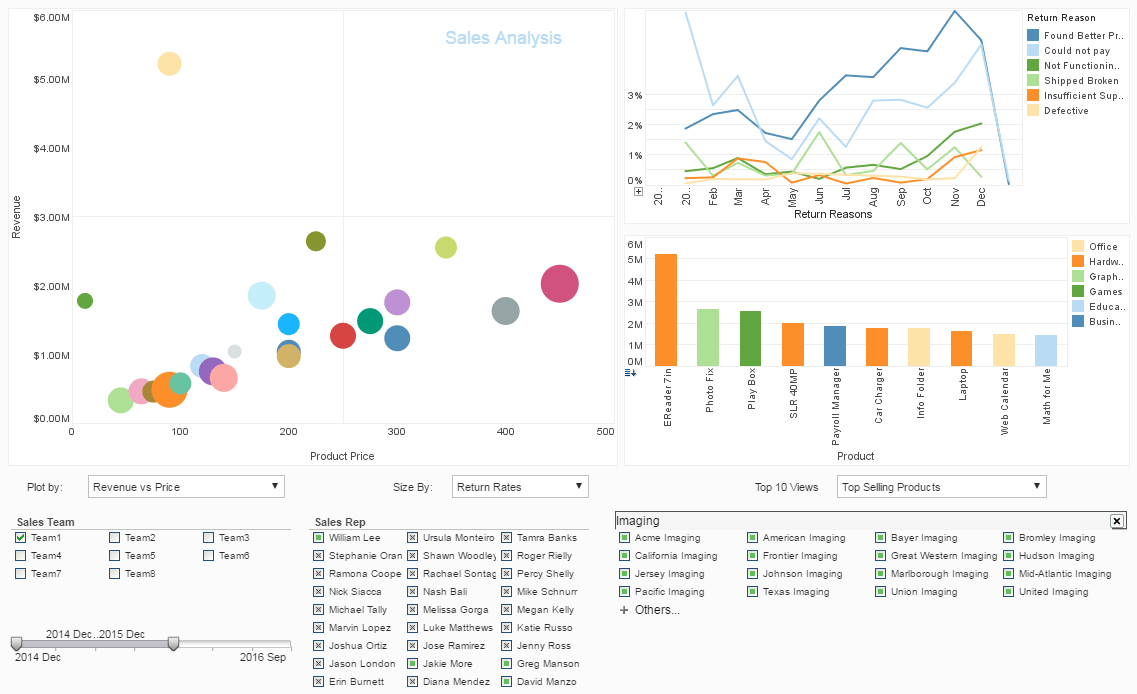Advice for Creating Marketing Dashboards
This is of the continuation of the transcript of a webinar hosted by InetSoft on the topic of "The Value of Marketing Executive Dashboards"
So I have some bits of advice for creating marketing dashboards today, and I'm just going to share them. Please take them for that they're worth, and choose for what makes sense for your company. The first bit of advice I have is: choose your metrics wisely.
There's a lot of data out there. There are a lot of things that you're doing in the marketing funnel and working with your sales team and your organization from strategy all the way down to campaign tactics. So you need to watch the metrics of what matters.
The metrics need to be the things that are changing your business or helping you do your job whether that's from brand building and awareness at the top of the funnel down through demand generation and qualification and end of the sales cycle.
Even understanding how the sales cycle works is really important for us marketers, and of course, at the end of that sales cycle it is customers won or lost that matters. Lost prospects need to be measured all along the sales process.
Measure Customer Satisfaction
Even at that level, it's very important to be measuring customer satisfaction, their experience, the upsell opportunities, how to retain those customers once won, and how well are you doing growing those customers' business. And of course, when you lose business is it important for you to measure your recapture capabilities and to diagnose why you lost them.
So really you should be thinking about the whole funnel in terms of measuring what matters, not just the typical things like how many people responded to an email campaign, or what have you. Think across your funnel or through your funnel. You know, one thing I love is this little image here that I borrowed from a great book about demand generation.
If you are measuring metrics that aren't going to change how you behave, what is the point? In fact if a metric won't change how you behave, it's a bad metric. It's a vanity metric. There's no point to it. So don't waste your time on measuring things that don't matter, that you can't influence, or that you won't be able to change. Now, that doesn't mean you shouldn't measure things that you think you might consider changing in the future to give yourself some history and experience with it, but don't measure things that you just can't really do much about.
Another bit of advice is to make your dashboard metrics easy to see and understand. This goes back to one of the qualities of a great dashboard of any kind. We all are facing so much data and so much technology, I know you're as overwhelmed as I am and my colleagues. Every one of the systems in place at your company generates some kind of stream of data, and you may have 5, 6, 10, 12 of these different systems. So you're faced with a lot of data.
When you're faced with that much data, you should really be taking advantage of one of your best assets, or all of our best assets, and that is your human perceptual system, your eyes, your eyesight. Seventy percent of our senses are in our eyes compared to the other senses, so we should be taking advantage of those and making the most of them.
Let me give you an example of what I mean. Here's a a table of media activity versus website traffic. It's quite an easy metric to understand. This is a typical report. You probably scroll to the end to see the latest data and find out what's going on and try to figure out what the pattern is between fresh hits and average daily new visitors.
However, what if you could look at a visual representation of that data? This is literally a visual chart of the data I just showed you. The purple line is average daily unique visitors. The blue Xs are news articles, and the orange +s are press releases. You can see is there a pattern between traffic and not traffic. When are things changing, when are things coming up and down? That becomes a more useful tool than the tabular report which is really asking you to do a lot of work to figure out if there is a relationship between website traffic and press activity.


